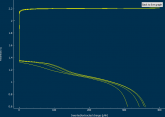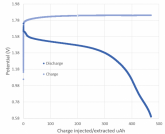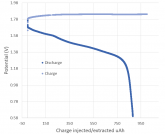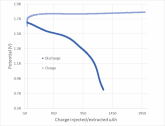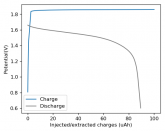danielfp248
Battery researcher
- Joined
- Sep 7, 2020
- Messages
- 429
Hi Guys,
My name is Daniel, I am a chemist with a passion for battery technology and currently trying to build a highly efficient Zinc-Bromine battery at home using readily available materials. I have a blog where you can follow my progress (https://chemisting.com/). I am using a DIY USB potentiostat/galvanostat (read about how to build it here https://www.sciencedirect.com/science/ar...7217300317) in order to properly characterize the batteries I build and in this way systematically modify/improve my builds.
Right now my electrolyte is a solution containing 0.5M Zinc Bromide + 0.2M Tetrabutylammonium bromide (TBAB)
I am using Swagelok cells for the construction of the test cells (0.5 inch diameter). This is the current configuration I have tested:

So far I have achieved a 96% Coulombic efficiency, although my specific capacity sucks, at around 1.0 mAh/g of cathode material. I am going to change to a Zn anode and to carbon paper cathodes (see my latest blog post), which should help increase the specific capacity by a factor of 10-100x. This is what I hope to reproduce, from recent research papers about this battery type (stationary Zn-Br batteries).
Any suggestions/comments/questions are welcome!
My name is Daniel, I am a chemist with a passion for battery technology and currently trying to build a highly efficient Zinc-Bromine battery at home using readily available materials. I have a blog where you can follow my progress (https://chemisting.com/). I am using a DIY USB potentiostat/galvanostat (read about how to build it here https://www.sciencedirect.com/science/ar...7217300317) in order to properly characterize the batteries I build and in this way systematically modify/improve my builds.
Right now my electrolyte is a solution containing 0.5M Zinc Bromide + 0.2M Tetrabutylammonium bromide (TBAB)
I am using Swagelok cells for the construction of the test cells (0.5 inch diameter). This is the current configuration I have tested:

So far I have achieved a 96% Coulombic efficiency, although my specific capacity sucks, at around 1.0 mAh/g of cathode material. I am going to change to a Zn anode and to carbon paper cathodes (see my latest blog post), which should help increase the specific capacity by a factor of 10-100x. This is what I hope to reproduce, from recent research papers about this battery type (stationary Zn-Br batteries).
Any suggestions/comments/questions are welcome!
Last edited:



